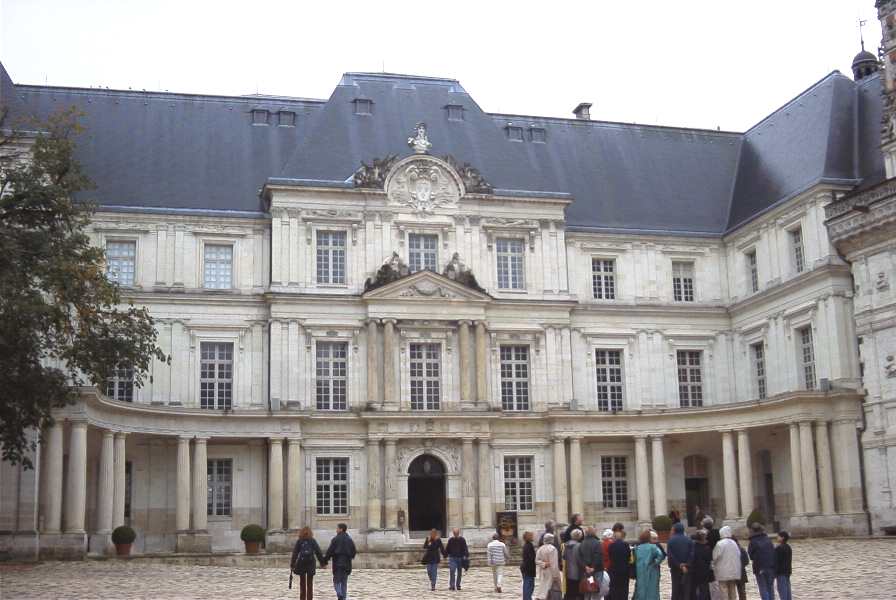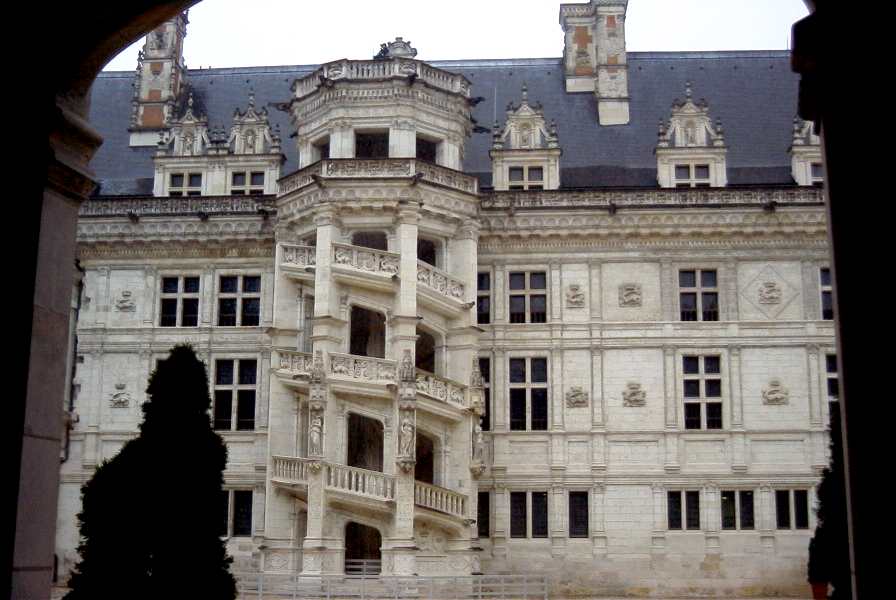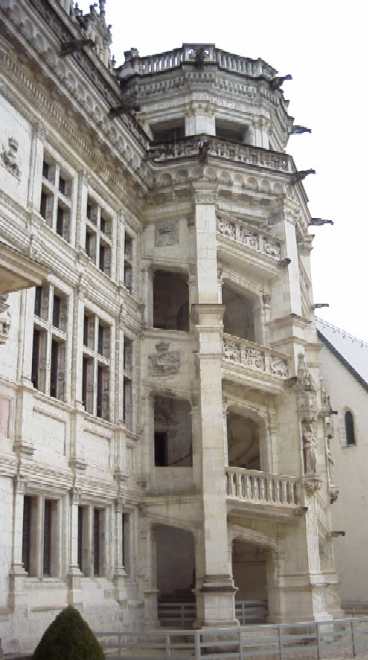

The French Baroque Classic hall at Blois
We arrived at Blois to find it closed for lunch like a lot of the tourist sights in the provinces. By the time we parked and walked up the steep path to its gates, it had opened; but a fierce rain started which was to last, on and off, for the rest of our last day of site-seeing.
Blois bloomed under Francois I in the early 16th century. Francois was quite a builder as we will see in our next page on Chambord Chateau. Under Francois, the French court grew as he invited the intellectuals of his day to festivals of previously unknown elegance. Keep in mind that the court was a moveable feast, primarily between the Louvre and the Loire valley castles. Like Bedouins, the court would pack up paintings, tapestries, clothing, furniture (everything but the kitchen sink and roof) and head to a different castle several times a year.
But Francois considerably raised the stakes of what constituted a royal retinue increasing it to about 15,000 people with 12,000 horses to move it in a time where the average French town contained about 10,000 people.
Francois I was one of only 7 kings and 11 queens to spend considerable time at Blois between 1500 and 1715. Like Chinon, Blois was the seat of power during a very troubled time for France. While Chinon was home to the Dauphin and Joan of Arc while the French were attempting to reestablish the power of their monarchy, Blois was the center of the religious wars (including the St. Bartholomew massacre that occurred in Paris, about a mile from where we live today).
Blois contained an extensive garden (now lost) and Francois I's prize library which moved two blocks from our present Paris apartment to the Bibliotheque Nationale de France.
What remains is really four different chateaux of severally contrasting styles -- all of which present themselves as a history of French architecture when viewed from the courtyard.
Visitors enter through the 13th century assembly room -- the largest Gothic civic hall in France which was used for an early version of Parliament called the States General. This leads to the Louis XII wing -- the oldest section built by, of course, Louis XII who was born at Blois in 1462. Louis moved the Loire court here and laid out a large terraced garden (since gone). His wing is shaped in an L and contains Italian Renaissance features with some mediaeval touches. Today it contains the Blois town museum.

Fourteen years after Louis XII completed his wing, his son started the Francois I wing with a mediaeval fašade (note the lack of symmetry in the windows below) but an early Renaissance staircase which originally was at the center of the building before a later addition (see below) shortened its exterior view. This octagonal "hors oeuvre" (meaning in front of the building) staircase allowed Francois I and his queen to make a dramatic balcony appearance to those gathered in the courtyard. (Apparently this stairs allowed Francois to rise to any occasion as his queen, Claude de France, bore 7 children in 8 years and died at age 2. After her death, Francois never frequented Blois again.)

Here's the staircase from a different angle:

Inside this wing, in the kings bedroom occurred the infamous 1588 assassination of Henri de Guise, a leader of the States-General. De Guise wanted to depose King Henry III (Francois I's grandson and one of three sons of Catherine de Medici to be the King of France). The reason? Henry's support for the Protestants in the religious wars. An important detail of De Guise's assassination is that he had just finished eating a couple of prunes. Despite this, he killed 4 of the 8 men on the murder squad. (Henry III, who was hiding behind a wall covering while all of this was going on, was himself stabbed to death 8 months later).
Also inside this wing, Marie de Medici was banished by her son, King Louis XIII. Somehow she managed to escape out a window on a rope ladder and through the moat. In her room is found the only royal cabinet relatively intact from the French Renaissance. It contains 180 sculpted oak panels with some hidden pockets that legend holds Marie used to hide poisons. (Italian cooking has improved considerably since then.)
The lowest floor of this wing contains an archeological museum with pre-historic stone tools, pottery, etc.
Across from the Louis XII entrance is the Gaston D'Orleans wing shown at the top of this page. Gaston (1608-1660) was a rebellious prince banished by Cardinal Richelieu who devoted his time to helping the famous Parisian architect Mansart create a new building. It is now thought to be a classic of the French Baroque symmetrical style.
It was Gaston's intent to tear down the other buildings so as to create an architecturally harmonious palace. Fortunately he ran out of money and died (in the Francois I Wing, since his palace wasn't finished) before he could accomplish this. On the day we visited, a display of the Medici treasures was the featured exhibition inside this building.
Where do you want to go today? Here's a few choices:
